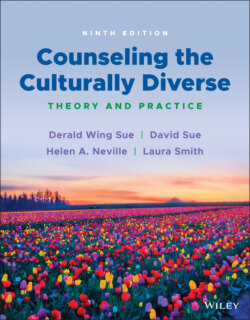Читать книгу Counseling the Culturally Diverse - Laura Smith L. - Страница 113
DILEMMA 2: THE INVISIBILITY OF UNINTENTIONAL EXPRESSIONS OF BIAS
ОглавлениеHow could Jaylen or Melanie “prove” that people or colleagues engaged in microaggressions against them? When Jaylen observes that the seat not taken on a crowded bus is always next to him, and when Melanie feels unwelcomed by portraits of only male Presidents of the University, they are met with disbelief and invalidations of their interpretations. These incidents are easily explained away and disregarded by others with alternative explanations. In the case of Jaylen, many might observe that there was probably other empty seats on the bus, that many passengers preferred to stand, and that he is misreading the situation; in the case of Melanie, she would be told that the university had male portraits because it was an accurate reflection of the history of the university, and it was not meant to make her feel excluded.
As we indicated earlier, microaggressions are oftentimes reflections of implicit bias, the racial and gender attitudes and beliefs that lie outside the level of conscious awareness. Because most people are well intentioned and experience themselves as good, moral and decent human beings, they find it difficult to entertain the notion that they have behaved in a racist or sexist manner (Sue, 2015). That the microaggression is essentially invisible to the perpetrator creates a psychological dilemma for the victim that can leave them feeling frustrated, powerless, and even questioning their own sanity (Bostwick & Hequembourg, 2014; Harper, 2013; Sue, Capodilupo, & Holder, 2008; Watkins et al., 2010). Helping professionals who are unable to understand the potent impact of microaggressions in the lived experience of marginalized groups, may unintentionally commit microaggressions toward them by dismissing, negating or diluting the harmful impact they pose on culturally diverse clients.
